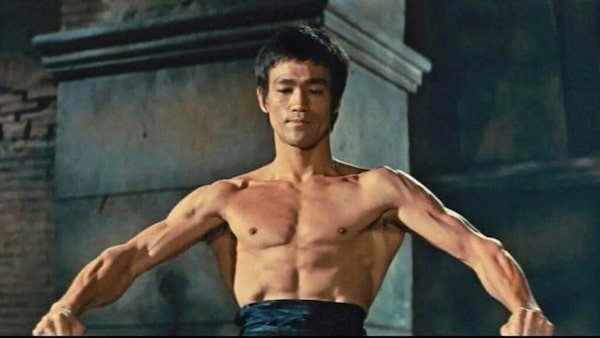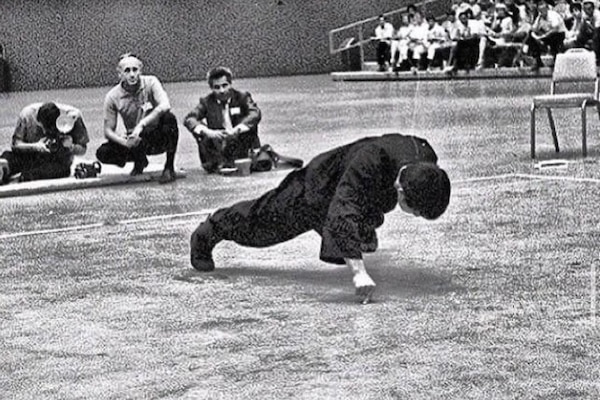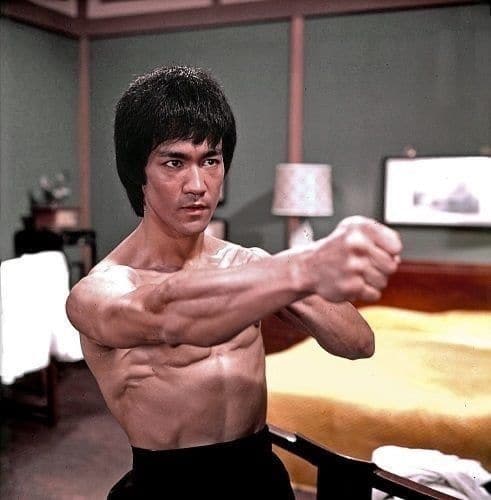
If we’ve learned one thing this year about what the ladies find attractive in men, it’s forearms: forearms sticking out of rolled-up sleeves; forearms gripping steering wheels; forearms handling tools. Women love the look of a man’s well-developed forearms.
Strong forearms are functional too: they improve your throwing capacity and help you lift, carry, and hold things better.
If you’ve wanted to build bigger, stronger, more defined forearms, today we’ll get a tutorial on how to do so from someone who raised forearm development to an art: Bruce Lee.
A Dragon’s Forearms
But there wasn’t room in that article for delving into how Lee worked his forearms, an area of his body he was especially committed to developing. Lee believed that forearm strength was essential to punching power and grip strength, capacities that were fundamental to his life’s great goal: becoming the best martial artist in the world. And, as someone who desired to fully express the beauty of his body, he appreciated the aesthetics of muscular forearms as well.
Lee’s wife Linda called him “a forearm fanatic.” The martial artist Bob Wall remembered: “Bruce had the biggest forearms proportionate to anybody’s body that I’ve ever seen. I mean, his forearms were huge! He had incredibly powerful wrists and fingers—his arms were just extraordinary.” Another friend said that “If you ever grabbed hold of Bruce’s forearm, it was like grabbing hold of a baseball bat.”
Bruce Lee’s Forearm Exercises

The forearms include numerous muscles that can be broadly categorized into two groups: the flexors (on the underside of the forearm) and the extensors (on the top of the forearm).
To develop truly meaty forearms, you’ve got to do exercises that work both of these groups of muscles. As you do so, your forearms will not only develop in size, definition, and strength, but you’ll improve the stability, endurance, and stamina of your wrists and grip as well.
Lee only lifted weights three times a week, but he trained his forearms every single day, doing a variety of exercises that trained all of their muscles.
While Lee commissioned the creation of several special forearm-training apparatuses, most of the exercises he did, which we’ll detail below, can replicated by the average joe:
Wrist Roller. Lee was a big fan of this classic forearm exercise, which targets both the extensors and the flexors of the forearms. To perform it, you need a wrist-roller device: a bar/rod from which a rope hangs that attaches to a light weight (usually 5-10 pounds).
To perform the wrist-roll exercise, stand with your feet shoulder-width apart and hold the wrist-roller rod straight out in front of you with both hands, palms facing down. Begin rolling the weight up by rotating your wrists; focus on using your wrists to roll the rope around the bar, rather than moving your arms or shoulders. Don’t bend your elbows. Continue rolling until the weight reaches the top, near the bar.
Slowly lower the weight in a controlled way by reversing the motion.

Lee could perform push-ups with just two fingers (the index and thumb), of one hand.
Fingertip push-ups. Fingertip push-ups are performed as you would traditional push-ups, but instead of placing the entirety of the palm-side of your hand on the floor, you support the weight of your body with only your fingertips. As you get stronger at this exercise, try to progressively subtract a finger from each hand; Lee eventually got to the point where he could do this exercise with just two fingers from one hand.
Reverse Curl. The reverse curl targets the brachioradialis, a muscle of the forearm that flexes the forearm at the elbow; it will hit your forearm extensors as well.
Usually when you’re doing a curl, your palms are facing up; with a reverse curl, your palms are facing down. You stand with your feet shoulder-width apart, gripping the barbell or dumbbells with an overhand grip, hands about shoulder-width apart. Let your arms hang down in front of you, fully extended, with the barbell or dumbbells resting against your thighs.
Keeping your upper arms stationary, curl the weight upwards by bending your elbows. Focus on using your forearms to lift the weight, not your shoulders or upper arms. Raise the weight until your forearms are fully contracted and the weights are at shoulder height.
Now lower the weight slowly to the starting position, maintaining control throughout the movement. Fully extend your arms at the bottom of the movement to complete one repetition.
Seated Barbell Underhand Wrist Curl. The barbell wrist curl is an effective exercise for targeting the forearm flexors. Perform the exercise by sitting on a flat bench or on the edge of a seat with your feet flat on the floor.
Grip a barbell with your palms facing up, hands about shoulder-width apart. Rest your forearms on your thighs, with your hands projecting 2-3 inches in front of your knees. Curl the barbell up by flexing your wrists. Focus on using your forearm muscles to lift the weight, not your shoulders or elbows; only your hands should be moving. Raise the barbell until your wrists are fully flexed and the barbell is close to your forearms.
Slowly lower the barbell back to the starting position, extending your wrists and lowering the barbell as far as possible, without over-extending them to avoid unnecessary strain.
Seated Barbell Overhand Wrist Curl. Same as the above, but your palms should be facing down when you grip the barbell.
Zottman Curl. Named after the strongman George Zottman, the Zottman curl combines a standard bicep curl with a reverse curl and targets both the biceps and the forearms. To do a Zottman curl, stand with your feet shoulder-width apart and hold a pair of dumbbells with an underhand grip (palms facing up), arms fully extended by your sides. Keep your upper arms stationary and curl the dumbbells up towards your shoulders by bending your elbows. Keep the motion controlled and squeeze your biceps as you lift the weights.
When the dumbbells are at shoulder height, rotate your wrists to an overhand grip (palms facing down).
Slowly lower the dumbbells back down to the starting position with your palms facing down. Once your arms are fully extended, rotate your wrists back to the underhand grip to start the next repetition.
Do not use momentum to lift and lower the weights and don’t swing them. Ensure you complete the full range of motion during all phases — fully extending and contracting your arms.
Leverage Bar Curls. In his forearm training, Lee made frequent use of leverage bars. You can, too. A leverage bar is any implement that you grip off-center. By performing standard exercises, like curls, with the weight thus unequally distributed, you work your muscles in a different way.
To do a leverage bar curl, grab a loadable dumbbell in one hand. To get the lever effect, hold the dumbbell closer to one end. This will make the lift much harder. Your arm should hang naturally at your side with your wrist in a neutral position. Slowly curl your wrist upward as far as you can go. Then slowly lower the dumbbell to the starting position. That’s one rep. You can add weight to the end of the dumbbell that you’re not holding for added resistance.
Reverse Leverage Bar Curls. This is the same thing as above, but you point the end of the dumbbell behind you. Curl wrist up and lower. This will work a different part of your forearm.
Leverage Bar Twist/Rotations. Hold a dumbbell by one end with your arm bent at 90 degrees. Rotate the dumbbell side to side.
Isometric Squeeze. Isometric exercises played a big role in Lee’s overall fitness routine, including when it came to building forearm strength. One of Lee’s exercise rules for himself was “Carry sponge gripper and use daily as much as possible.” While we don’t know exactly what this “sponge gripper” was, it seems to be something he could squeeze, using isometric resistance to build his grip and forearm strength. Similar results can be achieved by using a classic spring-loaded gripper or even a tennis ball.
Bruce Lee’s Forearm Workout

Bruce Lee performed a dedicated forearm workout every day. Here’s an example of one of his typical routines:
- Underhand Wrist Curl: 4 sets x 17 reps
- Overhand Wrist Curl: 4 x 12
- Leverage Bar Curl: 4 x 12
- Reverse Leverage Bar Curl: 4 x 12
- Reverse Curl: 4 x 6
- Wrist-Roller: 4 complete windings
- Leverage Bar Twist: 3 x 10
In addition to doing his daily dedicated forearm workout, Lee also did forearm exercises at random times throughout his day, whether he was at home or on a movie set. According to his wife Linda, he did Zottman curls whenever he had a spare moment, often performing them with one arm while he read a book with the other.
He also used a gripping machine he had designed and kept in his office and cranked out reps on it when he had moments of downtime in between tasks and squeezed his sponge gripper as he went about his daily routine. You can replicate these exercises by keeping a gripper (I like these from Captains of Crush) in your desk drawer and squeezing out a few reps whenever you have a chance.
With a little dragon-like passion and a dose of Lee’s dedication, you’ll be filling out your shirt sleeves in no time.
Source:
Bruce Lee: The Art of Expressing the Human Body by John Little
Help support independent publishing. Make a donation to The Art of Manliness! Thanks for the support!


0 Commentaires